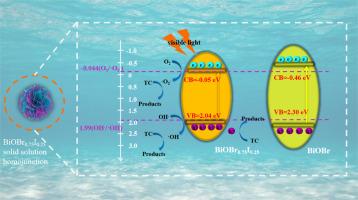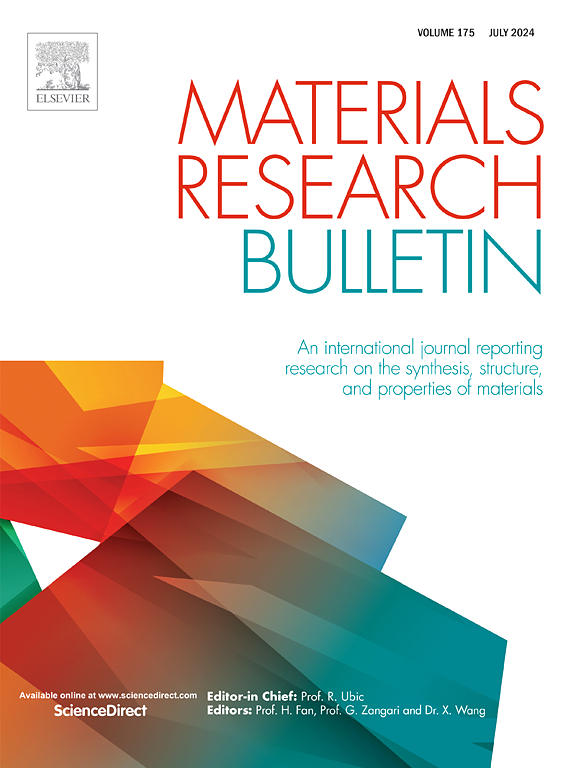Interfacial coupling mechanism for efficient degradation of tetracycline by heteroatom iodine (I)-doped BiOBr under visible light: Efficacy and driving force
IF 5.3
3区 材料科学
Q2 MATERIALS SCIENCE, MULTIDISCIPLINARY
引用次数: 0
Abstract
Studies on photocatalytic materials frequently focus on two pivotal metrics: the generation and separation capabilities of photoinduced charge carriers. In this context, we developed a diverse range of BiOBrxI1-x solid solutions (x = 1, 0.75, 0.50, 0.25, 0) via a simple room-temperature synthesis. The BiOBr0.75I0.25 solid solution demonstrated a remarkable degradation ability (up to 88.4 %) for tetracycline (TC) within a span of 60 min under visible light. This efficiency was attributed to enhanced light absorption within the visible region and improved segregation of photoinduced charges. A systematic study was performed to determine the influence factors of the degradation efficiency and the roles of different reactive species. A comprehensive photocatalytic mechanism was proposed on the basis of the results of X-ray photoelectron spectroscopy (XPS) and density functional theory (DFT) calculations. Finally, theoretical calculations were integrated with liquid chromatography-mass spectrometry (LC-MS) results to propose a degradation pathway for BiOBr0.75I0.25.

杂原子碘(I)掺杂的 BiOBr 在可见光下高效降解四环素的界面耦合机制:功效和驱动力
有关光催化材料的研究通常关注两个关键指标:光诱导电荷载流子的产生和分离能力。在此背景下,我们通过简单的室温合成技术开发出了多种 BiOBrxI1-x 固溶体(x = 1、0.75、0.50、0.25、0)。在可见光下,BiOBr0.75I0.25 固溶体在 60 分钟内对四环素(TC)有显著的降解能力(高达 88.4%)。这一效率归因于可见光区域内光吸收能力的增强和光诱导电荷分离的改善。为确定降解效率的影响因素和不同反应物的作用,进行了系统研究。在 X 射线光电子能谱 (XPS) 和密度泛函理论 (DFT) 计算结果的基础上,提出了一种全面的光催化机理。最后,将理论计算与液相色谱-质谱(LC-MS)分析结果相结合,提出了 BiOBr0.75I0.25 的降解途径。
本文章由计算机程序翻译,如有差异,请以英文原文为准。
求助全文
约1分钟内获得全文
求助全文
来源期刊

Materials Research Bulletin
工程技术-材料科学:综合
CiteScore
9.80
自引率
5.60%
发文量
372
审稿时长
42 days
期刊介绍:
Materials Research Bulletin is an international journal reporting high-impact research on processing-structure-property relationships in functional materials and nanomaterials with interesting electronic, magnetic, optical, thermal, mechanical or catalytic properties. Papers purely on thermodynamics or theoretical calculations (e.g., density functional theory) do not fall within the scope of the journal unless they also demonstrate a clear link to physical properties. Topics covered include functional materials (e.g., dielectrics, pyroelectrics, piezoelectrics, ferroelectrics, relaxors, thermoelectrics, etc.); electrochemistry and solid-state ionics (e.g., photovoltaics, batteries, sensors, and fuel cells); nanomaterials, graphene, and nanocomposites; luminescence and photocatalysis; crystal-structure and defect-structure analysis; novel electronics; non-crystalline solids; flexible electronics; protein-material interactions; and polymeric ion-exchange membranes.
 求助内容:
求助内容: 应助结果提醒方式:
应助结果提醒方式:


